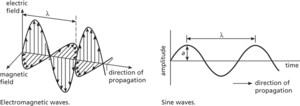A periodic disturbance in a medium or in space. In a travelling wave (or progressive wave) energy is transferred from one place to another by the vibrations (see also stationary wave). In a wave passing over the surface of water, for example, the water rises and falls as the wave passes but the particles of water on average do not move forward with the wave. This is called a transverse wave because the disturbances are at right angles to the direction of propagation. The water surface moves up and down while the waves travel across the surface of the water. Electromagnetic waves (see diagram) are also of this kind, with electric and magnetic fields varying in a periodic way at right angles to each other and to the direction of propagation. In sound waves, the air is alternately compressed and rarefied by displacements in the direction of propagation. Such waves are called longitudinal waves.
The chief characteristics of a wave are its speed of propagation, its frequency, its wavelength, and its amplitude. The speed of propagation is the distance covered by the wave in unit time. The frequency is the number of complete disturbances (cycles) in unit time, usually expressed in hertz. The wavelength is the distance in metres between successive points of equal phase in a wave. The amplitude is the maximum difference of the disturbed quantity from its mean value.

Wave.
Generally, the amplitude (a) is half the peak-to-peak value. There is a simple relationship between the wavelength (λ) and the frequency (f), i.e. λ=c/f, where c is the speed of propagation. The energy transferred by a progressive sine wave (see diagram) is proportional to a2f2. See also simple harmonic motion.
A disturbance within a medium, such as sound or electromagnetic waves. A sound wave transfers its energy from particles to adjacent particles and so needs a medium to propagate. Electromagnetic waves can also travel through a vacuum.
If the disturbance is given by the equation
then A is the wave’s amplitude, ε is the phase, ω is the angular frequency, 2π/ω is the period, k is the wavenumber, 2π/k is the wavelength, and ω/k is the speed of the wave’s propagation. See wave equation, longitudinal wave, transverse wave.
A periodic disturbance, either continuous or transient, that is propagated through a medium or through space and in which the displacement from a mean value is a function of time or position or both. Sound waves, water waves, and mechanical waves involve small displacements of particles in the medium; these displacements return to zero after the disturbance has passed. With electromagnetic waves (see electromagnetic radiation) it is changes in the intensities of the associated magnetic and electric fields that represent the disturbance and a medium is not required for propagation of the wave.
The instantaneous values of the periodically varying quantity plotted against time gives a graphical representation of the wave that is known as the waveform. If the waveform is sinusoidal in shape it is usually described as undistorted; a nonsinusoidal waveform is distorted. The wavefront is the imaginary surface over which the displacements are all of the same phase. The amplitude of the wave is the peak value of the displacements relative to the equilibrium state or to some arbitrary reference level, usually zero. If a wave suffers attenuation the amplitude of successive periods is continuously reduced (see also propagation coefficient).
The wavelength is the distance between two displacements of the same phase along the direction of propagation. If v is the velocity of the wave and λ its wavelength, then the frequency of vibration, f, is given by
The frequency is the reciprocal of the period, T, of the wave. The frequency (or wavelength) of electromagnetic radiation is commonly used to describe particular regions of the electromagnetic spectrum, such as the visible or radio regions (see also frequency band).
An alternating current propagated through a long chain network or filter behaves as if it were a wave. Elementary particles, such as electrons, have associated wavelike characteristics. See also Doppler effect.
A periodic disturbance in a solid, liquid, or gas as energy is transmitted through the medium. (Electromagnetic waves e.g. light, can be transmitted through a vacuum.) In water, waves may occur either at the surface or as internal waves. The size of the water wave varies from minute capillary waves to massive tsunami, while wave period ranges from a few seconds to several hours.
A ridge of water between two depressions. Wave height is the difference in elevation between the wave crest and the wave trough. The height of a wave is generally proportional to the square of wind velocity.
The wavelength is the distance between successive crests (or troughs), and the wave period is the time it takes for the wave to travel a distance equal to its wavelength. Wave steepness is given by the ratio of wave height to wavelength H/L. Significant wave height Hs is the average of the highest one-third of the waves, and can be obtained by recording a time series of water depth and multiplying the associated standard deviation by four. See linear wave theory.
Wave shoaling is the process whereby waves change in height as they travel into shallower water and make contact with the seabed. Short and Brander (1999) J. Coastal Res. 15, 3 suggest that distinct morphodynamic scaling exists between various wave energy environments.
Waves are the moving force in longshore drift. See Watt et al. (2005) Procs Coast. Dynam. on surface sediment distribution patterns in response to wave conditions.
- counterpart theory
- counter-party
- Oldham, Richard Dixon
- Oldham, Richard Dixon (1858–1936)
- Oldowan
- old quantum theory
- Old Red Sandstone Continent
- Oldshue–Rushton column
- Old Style date
- Old Tom the Killer Whale
- Olduvai
- OLE
- oleaginous
- oleate
- olecranon process
- OLED
- olefines
- olefins
- oleic acid
- Olenekian
- Olenelloidea
- oleosome
- oleum
- olfaction
- olfactory lobe